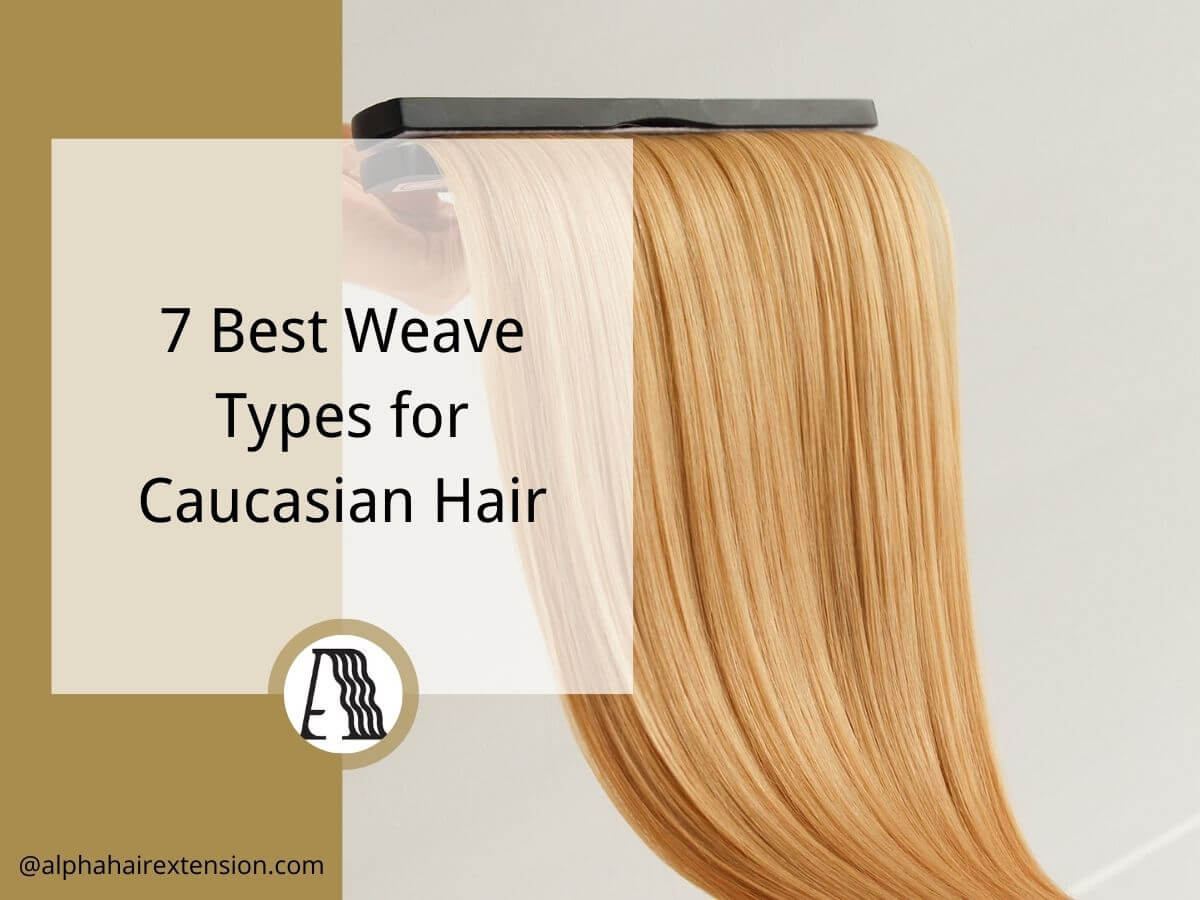A client once called me in a panic. Their shipment of hair extensions had arrived, but the hair was dry, tangled, and shedding. I knew the product was high quality when it left our warehouse, so what went wrong?
It was how they stored it.
I’ve seen this happen again and again. Perfectly good hair extensions lose their value because they weren’t stored correctly.
The result? Lost sales, unhappy customers, and damaged brand reputation.
But you don’t have to worry.
In this article, I’ll show you how to store hair extensions the right way. You’ll learn simple yet effective techniques that will keep your inventory in top shape, maintain quality, and extend the lifespan of your products.
So let’s get started!
1. Preparing Hair Extensions for Storage
Storing hair extensions the right way starts with proper preparation. If you skip these steps, the hair can dry out, tangle, or even develop odors over time. Taking a few minutes to prep your extensions before storing them will help maintain their softness and quality.
Step#1: Clean and Dry Before Storing
Never store hair extensions without washing them first. Product buildup, sweat, and dust can cause tangling and even attract bacteria.
- Wash the extensions with a gentle, sulfate-free shampoo to remove dirt and oils.
- Use a lightweight conditioner to keep them soft. Avoid anything too heavy.
- Rinse thoroughly and gently squeeze out excess water with a towel.
Drying is just as important. Never store damp extensions. Trapped moisture can lead to mold, mildew, or a musty smell. Air-dry them completely by laying them flat or hanging them in a cool, dry place.
Step#2: Detangle Properly
Tangles get worse in storage. Before putting the extensions away, take time to detangle them carefully.
- Use a wide-tooth comb or a loop brush designed for hair extensions.
- Start at the ends and work your way up to prevent breakage.
- Be gentle. Pulling too hard can cause shedding.
Step#3: Apply Leave-In Conditioner (For Long-Term Storage)
If you’re storing extensions for a long time, they need moisture to stay soft. A light leave-in conditioner helps prevent dryness and brittleness.
- Choose a spray or lightweight formula to avoid buildup.
- Focus on the mid-lengths and ends. Avoid the roots to prevent greasiness.
- Skip heavy oils like coconut or castor oil—they attract dust and make the hair harder to clean later.
Taking these simple steps before storage will protect your investment and keep your hair extensions looking fresh and beautiful when you sell them.
2. Storage Methods for Different Hair Extension Types
Different types of extensions need different care. Whether you’re storing a few pieces or managing bulk inventory, the right method makes all the difference. Here’s how to do it.
Clip-In Hair Extensions
Clip-in extensions are popular because they’re easy to install and remove. But if you toss them in a drawer or a plastic bag, they can tangle fast. I’ve seen stylists struggle to detangle clip-ins right before a client’s appointment—don’t let that happen to you.
- Use a hanger or storage bag: A breathable fabric bag keeps them dust-free and smooth.
- Close the clips before storing: This prevents snags and damage.
- Brush the hair first: Always detangle before putting them away.
- Keep them in a cool, dry place: Avoid heat, moisture, and direct sunlight.
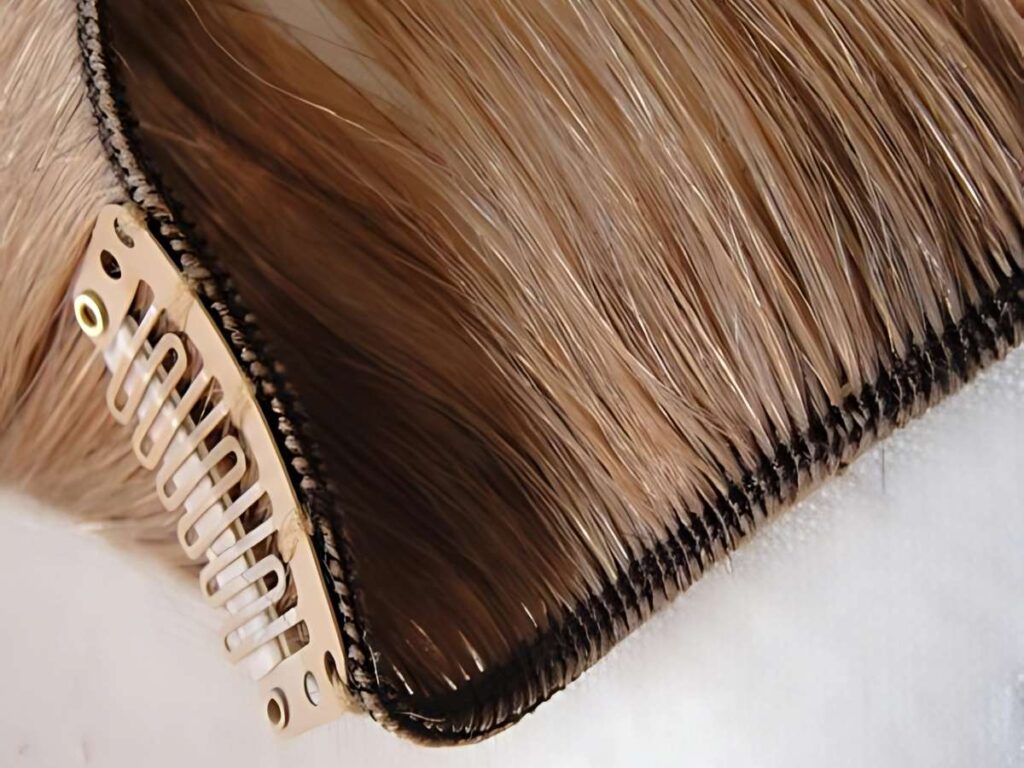
Tape-In and Weft Hair Extensions
I’ve had clients complain that their tape-ins didn’t last, only to find out they had been stored carelessly. Tape-ins and wefts need careful handling, or they’ll lose their quality before you even use them.
- Lay flat in a storage box: Folding or bending can damage the tape or stitching.
- Use wax paper or silicone sheets: This keeps the tape from sticking together.
- Keep away from extreme heat or moisture: Heat weakens the adhesive, and humidity affects the tape’s grip.
- Avoid stacking heavy items on top: This prevents flattening and damage.
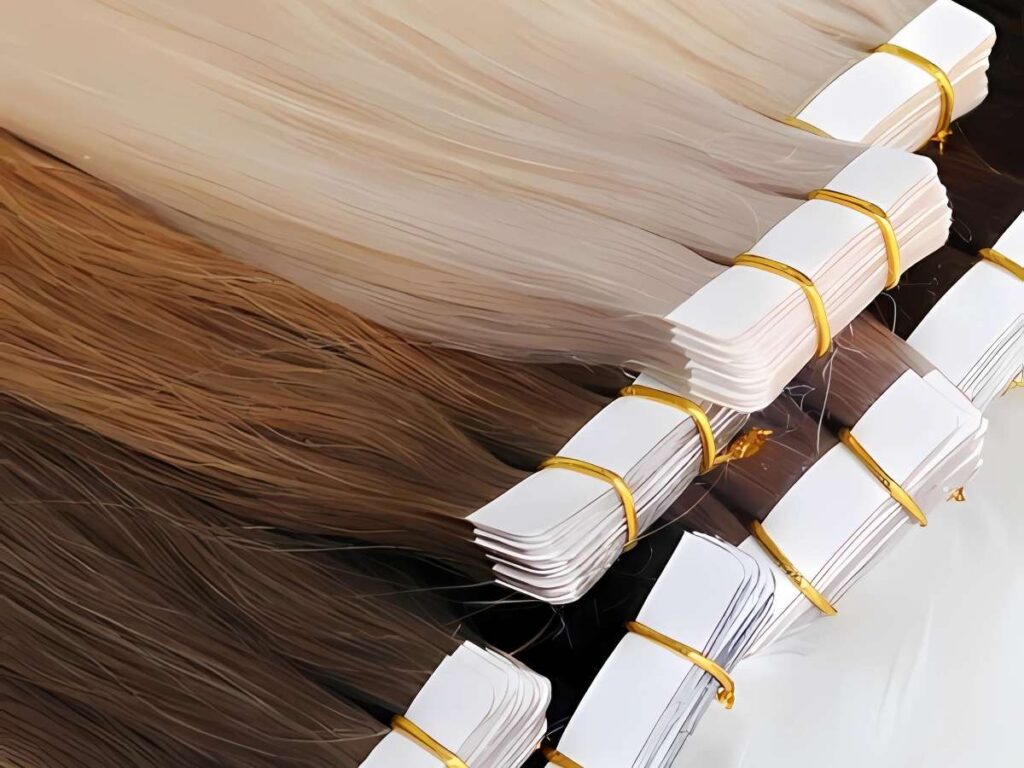
Wigs and Bundles
I once saw a client pull a wig out of a plastic bag, only to find it tangled and frizzy. Wigs and bundles need space to breathe.
- Use a mannequin head or silk bag: A mannequin keeps its shape, while a silk bag reduces friction.
- Wrap bundles in a satin scarf: This protects the cuticle and prevents frizz.
- Store upright: Hanging wigs prevents them from flattening or matting.
- Avoid direct sunlight: UV exposure can dry out and fade the hair.

Bulk Storage for Wholesale & Distribution
If you stock or distribute hair extensions, proper storage is even more important. A single mistake—like leaving products in a humid warehouse—can cost you thousands.
- Use airtight plastic containers or vacuum-sealed bags: This prevents dust, moisture, and pests.
- Label everything: Keep track of lengths, colors, and textures for easy access.
- Store in a climate-controlled space: Hair reacts to temperature. Avoid heat, humidity, and dryness.
- Rotate stock regularly: Follow a first-in, first-out system so older inventory doesn’t sit too long.
When you store hair extensions correctly, you protect your investment. Whether you run an online store, a salon, or a distribution center, these storage methods help maintain quality and keep your customers happy.
3. Step-by-Step Guide to Storing Hair Extensions Properly
Hair extensions are an investment. Whether you sell them, use them for clients, or stock them in bulk, proper storage makes a huge difference. I’ve seen businesses lose money because their hair became tangled, dry, or unusable just from improper storage. You don’t want that to happen.
So how do you keep extensions in perfect shape? Follow these steps to make sure your hair stays soft, smooth, and ready to use.
Step#1: Detangle the Hair
Before putting extensions away, always detangle them first. Storing tangled hair leads to knots that are almost impossible to fix later.
- Use a wide-tooth comb or soft-bristle brush – Avoid harsh brushes that can cause breakage.
- Start at the ends and work your way up – This prevents pulling and reduces shedding.
- Hold the hair in sections – It helps reduce tension and keeps strands smooth.
I once saw a stylist spend over an hour trying to fix a set of extensions that had been thrown into storage without detangling. Don’t make the same mistake. Taking a few minutes now will save you a lot of frustration later.
Step#2: Clean and Dry the Hair
Would you ever store damp clothes in a sealed bag? Of course not—they’d develop mildew and smell terrible. The same thing happens with hair extensions.
For Human Hair Extensions:
- Wash with sulfate-free shampoo and conditioner – This keeps the hair soft and hydrated.
- Rinse thoroughly – Any leftover product can cause buildup over time.
- Air dry completely before storing – Moisture leads to mildew and bad smells. Use a microfiber towel to absorb excess water, then lay the hair flat or hang it to dry.
For Synthetic Hair Extensions:
- Avoid washing unless necessary – Too much moisture weakens synthetic fibers.
- Wipe gently with a damp cloth – If the hair has dust or buildup, use a soft cloth with water.
- Let it dry fully – Just like human hair, damp synthetic hair can develop odors or lose its texture.
Dry, clean hair lasts longer in storage. Never rush this step.
Step#3: Store in a Protective Case
Now that the hair is clean, it’s time to put it away. The right storage method depends on how often it will be use.
For Frequent Use:
- Hang the hair on a specialized hanger – This prevents creasing and keeps the hair smooth.
- Use a satin or silk pouch – Unlike plastic bags, these materials help reduce frizz and static.
- Keep the hair in a cool, dry space – Heat and humidity can cause the hair to dry out or lose its shape.
For Long-Term Storage:
- Use a sealed plastic bag or box – This keeps dust, moisture, and pests out.
- Store in a drawer or designated storage case – A clean, organized space prevents tangling and damage.
- Label the storage container – If you manage inventory, labeling hair types, lengths, and colors makes organization easier.
A little extra effort in storage goes a long way. Properly stored extensions last longer, look better, and are easier to work with when you need them.
Are your extensions stored the right way? If not, now is the time to start.
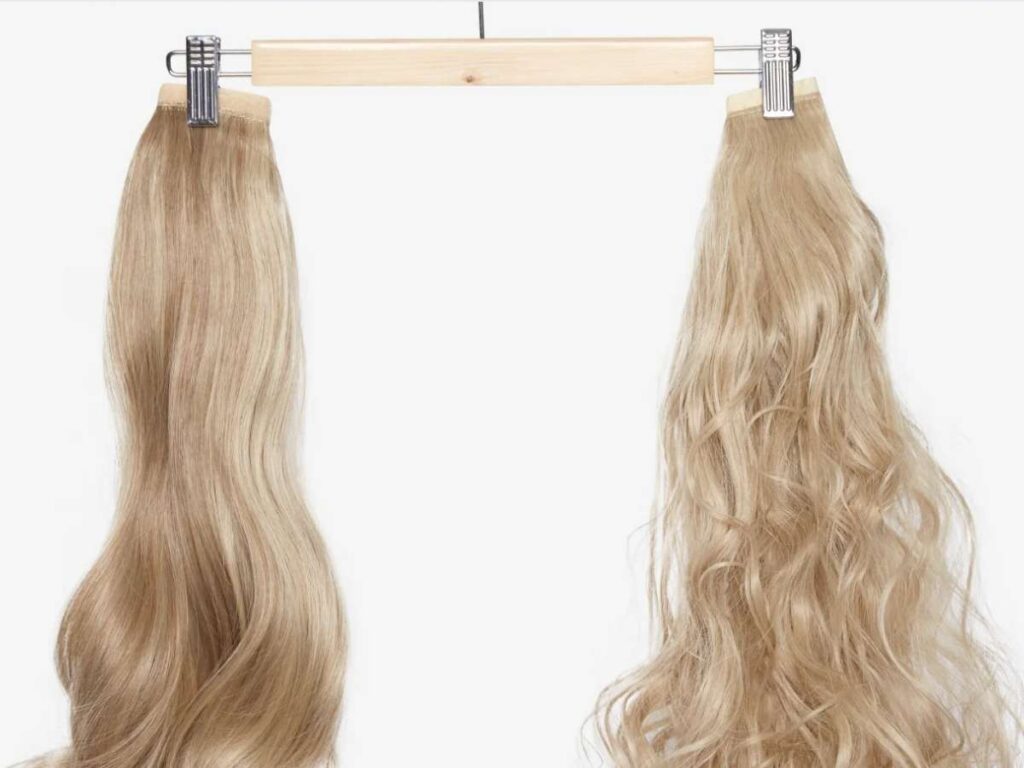
4. Storage Tips for Shipping & Transporting
I’ve seen businesses make avoidable mistakes—using flimsy packaging, skipping moisture control, or cramming hair into small boxes. These issues can easily be prevented with the right shipping practices. Here’s how to keep hair extensions in perfect condition during transport.
Tip#1 Use Hard Plastic Cases or Sturdy Boxes
Extensions can easily get flattened or tangled if packed incorrectly. A strong, structured case keeps them safe.
- For small orders: A hard plastic case keeps hair in shape and prevents friction.
- For bulk shipments: Sturdy boxes with reinforced corners help prevent crushing.
- Avoid overpacking: Pressing too many extensions into one package can cause creases and damage.
Imagine opening a package of beautiful extensions only to find them crushed and tangled. The right packaging prevents this from happening.
Tip#2 Include Moisture-Absorbing Silica Packs
Humidity is one of the biggest threats during shipping. It can lead to frizz, static, or even mildew in long-term storage.
- Place silica gel packs inside packaging to absorb moisture.
- Use airtight bags when shipping to humid locations.
- Store boxes in a dry area before shipping to prevent excess moisture buildup.
No one wants to receive hair that smells musty or feels damp. A simple silica pack can make all the difference.
Tip#3 Use Protective Foam Inserts
Movement during shipping can cause tangling and breakage. Securing extensions in place is key.
- Wrap each clip-in piece separately to prevent clips from catching on the hair.
- Use soft foam inserts or tissue paper between bundles to reduce friction.
- For longer hair, loosely coil it before placing it in packaging to avoid bending.
When hair stays in place, it arrives looking fresh, smooth, and ready to use.
Tip#4 Label Fragile or Delicate Items Clearly
Shipping carriers may not always handle packages with care. Proper labeling helps.
- Use “FRAGILE” stickers to encourage gentle handling.
- Include “Keep Dry” labels to prevent accidental moisture exposure.
- If needed, add handling instructions inside so recipients know how to store the hair properly.
A simple label can be the difference between a damaged shipment and a perfect delivery.
The way you package and store hair during shipping affects its quality upon arrival. Following these steps ensures that every extension reaches its destination looking its best. It’s a small effort that prevents big losses.
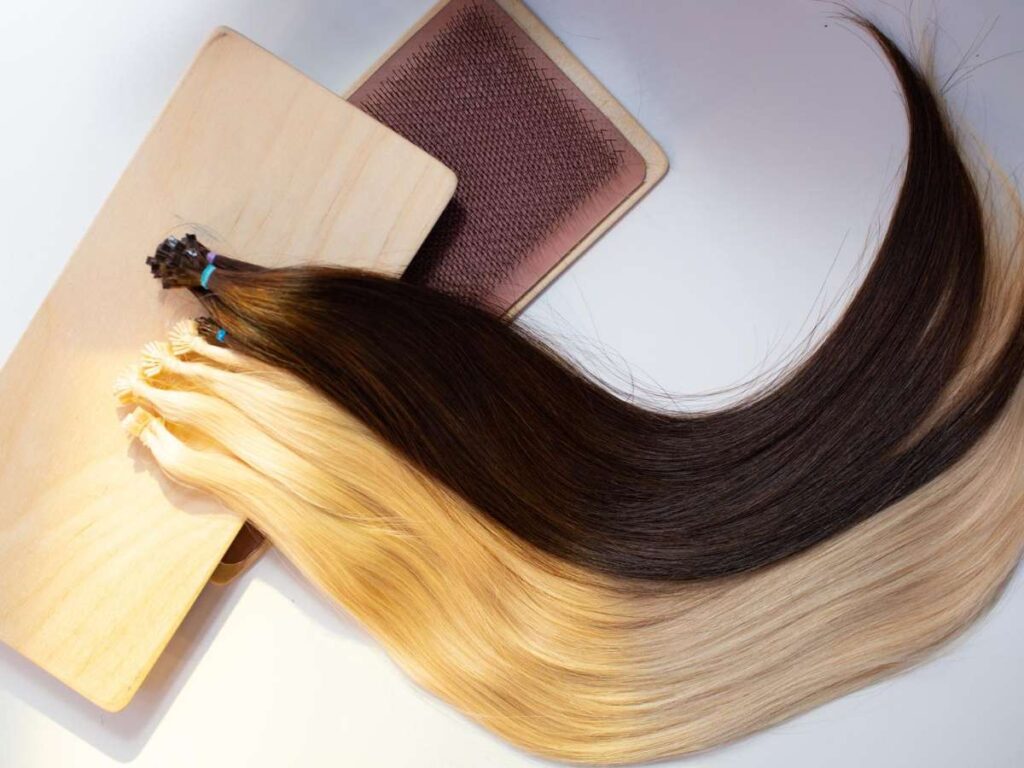
5. Common Mistakes to Avoid When Storing Hair Extensions
Storing hair extensions the wrong way can ruin them. I’ve seen businesses lose money because of simple mistakes—extensions drying out, developing odors, or becoming too tangled to use. The good news? These issues are easy to prevent.
Avoid these common storage mistakes to keep your hair extensions looking fresh and long-lasting.
Storing Hair Extensions in Plastic Bags for Too Long
Plastic bags might seem like a convenient option, but they can cause more harm than good.
- Plastic traps moisture, which can lead to mold or bad odors.
- Lack of airflow can make hair stiff and dry.
- Static buildup can cause unnecessary frizz and tangling.
If you need to use plastic temporarily, limit how long the hair stays inside. A satin or silk storage bag is a much better choice for long-term protection.
Keeping Extensions in Direct Sunlight
One business I worked with lost an entire batch of extensions because they were stored near a sunny window. The color faded, and the hair became weak.
- UV rays weaken hair strands, making them dry and brittle.
- Color fades faster, especially on dyed or treated extensions.
To prevent this, always store extensions in a cool, shaded area. If a window is nearby, use a protective bag or box to block the light.
Not Detangling Before Storage
Tangled extensions only get worse in storage. If you don’t brush them before putting them away, you’ll have a mess to deal with later.
- Matting leads to breakage, making hair difficult to revive.
- Brushing tangled hair later causes shedding and unnecessary damage.
- Hair becomes harder to use, wasting time when you finally need it.
Take a few minutes to detangle first. Use a wide-tooth comb or a soft brush and work from the ends up.
Storing in High Humidity Areas
Humidity can ruin extensions before you even realize it. I’ve seen customers complain about a musty smell in new orders, only to find out the hair was stored in a damp area.
- Too much moisture encourages bacterial growth, leading to a musty smell.
- Frizz and static become worse, making hair harder to manage.
- Tape-ins and adhesives weaken, causing extensions to lose their hold.
Store hair in a dry, temperature-controlled space. If humidity is a concern, add a few silica gel packs to absorb excess moisture.
Using Harsh Storage Conditions
I once saw a warehouse stuff bundles into tight plastic bins, thinking it would save space. When they opened them months later, the hair had deep creases that wouldn’t straighten out.
- Tight storage creates bends and creases that can be hard to fix.
- Hair strands weaken under constant pressure, leading to breakage.
- Extensions lose their natural fall, making them look unnatural when worn.
Instead, store hair flat, hung, or loosely coiled in a dedicated storage space. Make sure there’s enough room for the hair to stay in its natural shape.
Avoiding these mistakes is simple but makes a big difference. With the right storage habits, you can extend the life of hair extensions, prevent damage, and keep your inventory in top condition.
6. Best Practices for Long-Term Storage
Hair extensions can last a long time if stored properly. But if the conditions aren’t right, they can dry out, tangle, or even develop an unpleasant smell. Whether you’re keeping inventory for months or just storing extra stock, following these best practices will help maintain quality.
Maintain Optimal Storage Conditions
Long-term storage isn’t just about where you put the hair—it’s about the environment. Small changes in temperature, humidity, and airflow can affect the texture and lifespan of extensions.
- Temperature: Keep storage spaces cool and dry. The ideal range is 15-25°C (59-77°F). Too much heat can dry out the hair, while cold temperatures can make it stiff.
- Humidity: High humidity can cause frizz, static, and even mold. Try to keep humidity levels below 50% to prevent moisture buildup.
- Ventilation: Avoid sealing hair in airtight spaces without airflow. Stale air can lead to musty odors, especially for human hair extensions.
A well-controlled environment helps extensions stay soft, smooth, and fresh—even after months in storage.
Using Silica Gel Packs for Moisture Control
Moisture is one of the biggest threats to stored hair extensions. Even in a temperature-controlled space, humidity levels can fluctuate.
- Silica gel packs help absorb excess moisture, keeping the hair dry and fresh.
- Place them inside storage bags, boxes, or containers—especially if storing in humid climates.
- Replace the packs every few months to keep them effective.
Adding silica packs is a small step, but it makes a big difference. It keeps hair extensions in perfect condition, no matter how long they’re stored.
Conclusion
I’ve seen too many businesses lose hair extensions to poor storage. It’s frustrating, but it’s avoidable.
Now, you know the best methods to store hair extensions for both short-term and long-term use. You understand what works and what doesn’t.
The only question left is—will you make the necessary changes?
Don’t wait until extensions are damaged beyond repair. Take action now. A few small adjustments today will save you time, money, and inventory in the future. Protect your inventory, and protect your business.
If you’re unsure where to start, contact us today!
Explore More Helpful Resources
Want to see more products? We’ve got plenty of options that might just be the perfect fit for you:
- Pre-bonded Hair Extension
- I-Tip Hair Extension / Stick Tip Hair Extension
- Genius Weft/Flat Weft Extension
If you’re looking for more insights, we’ve put together a list of helpful articles that you might enjoy:
Still haven’t found what you’re looking for? Don’t hesitate to contact us. We’re available around the clock to assist you.


